7/15/2006 Community Gumbo
 Democracy Now (7/14/06)
Democracy Now (7/14/06)Noam Chomsky: U.S.-Backed Israeli Policies Pursuing "End of Palestine"; Hezbollah Capture of Israeli Soldiers "Very Irresponsible Act" That Could Lead To "Extreme Disaster"
The One Percent Doctrine: Journalist Ron Suskind on the Deliberate U.S. Bombing of Al Jazeera, Losing Bin Laden and More
 How high will New Orleans residents have to raise their homes?
How high will New Orleans residents have to raise their homes?In response to increasing pressure from residents to find out whether or not they would have to raise their destroyed homes in order to get flood insurance in the future, the Federal Emergency Management Administration announced Advisory Base Flood Elevations in April. Homeowners anticipated that FEMA would release building requirements that reflected updated base flood elevation values throughout the city. Instead, FEMA announced that all houses which sustained 50 percent or more damage would have to be raised to the higher of either three feet above the Highest Existing Adjacent Grade (HEAG), or the 1984 Flood Insurance Rate Map requirements.
Basic facts:
- The 1984 Flood Insurance Rate Maps (FIRM) are based on a Flood Insurance Study (FIS) of Special Flood Hazard Areas (SFHA).
- FIRMs require the elevation of the lowest habitable floor to be at the elevation indicated on the FIRM.
- The National Flood Insurance Program (NFIP) is a federal program established by the 1968 National Flood Insurance Act. Participation in the NFIP requires an agreement between communities and the federal government. Communities must meet standards in the issuance of building permits, and in managing coastal areas and flood plains.
- Base Flood Elevation (BFE) represents the average floodwater elevation for a 100-year flood event. This means that floors of buildings constructed to this standard will sit above floodwater and will avoid damage in all but the most severe flood events.
- New Orleans' 1984 BFE is formulated on criteria for flood areas protected by levees as per NFIP.
- The Recovery Guidance Advisory Base Flood Elevations (ABFE) assume that the U.S. Army Corps of Engineers (USACE) is on an aggressive path to repair and improve the flood control system.
- Flood zones B and X have no flood elevation indication, and no flood insurance is required.
The New Orleans City Council presented a public meeting on Thursday to consider the array of problems associated with implementing FEMA's Advisory Base Flood Elevations.
With 50 percent or more of a home's value damaged in zones B or X, the existing guideline to build at 1'4" above the crown of the road would no longer be acceptable.
The new ABFE requires homes in zones B and X to be raised to 3' above the Highest Existing Adjacent Grade. For most practical purposes, the HEAG is the crown of the road.
Before Hurricane Katrina, homeowners were required to have the first habitable floor raised to the 1984 Base Flood Elevation. In the following example, the house would have to be raised 3', since raising the house to the 1984 is only 1.5' -- less than the 3' required by the new ABFE.
The new ABFE's would eliminate slab home construction on properties damaged more than 50 percent of their value.
In the following example, the 1984 BFE is higher than the new 3' ABFE. The house must be raised 3.5' to the higher 1984 elevation.
In the following example, again, the 1984 BFE is the higher standard, and the house would have to be raised to 6.5' to that level. In this case, however, the homeowner might consider going higher than 6.5 feet to create an uninhabited garage or storage area under the house.
In this last example, again, the 3' ABFE guideline is the lesser value. The house would have to be raised 8.5' to the 1984 BFE.
Currently, the 1984 Base Flood Elevations are in effect. The ABFE has not been adopted by the City of New Orleans. This is causing considerable confusion, because while a decision by the city is pending, on some future date, the Louisiana Recovery Authority will probably require homeowners to follow the 3' ABFE guideline. Still, in many cases where homes sustained storm damage exceeding 50 percent of the house's value (not caused by flooding), or where flooding was greater than 3', the logic of forcing owners to follow the 3' guideline is still in doubt.
Related:
People Get Ready -- Damned if you do, damned if you don't
Advisory Base Flood Elevation presentation (pdf) (the original color slide Powerpoint presentation from which the above images were taken)
A Citizen's Guide To This Whole House Raising Thing, From Someone Who's Gone Through It (pdf)
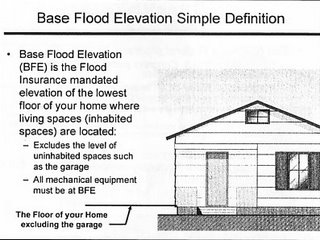
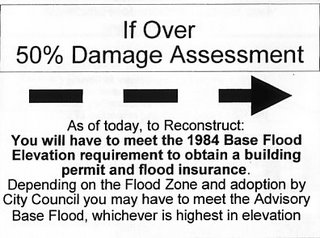
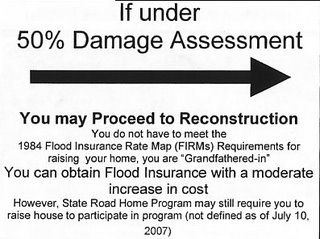

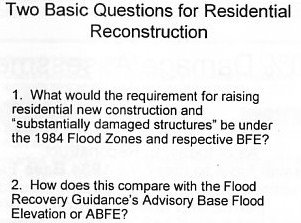
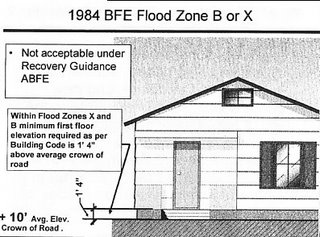
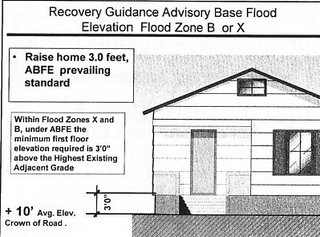

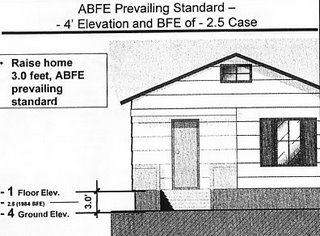
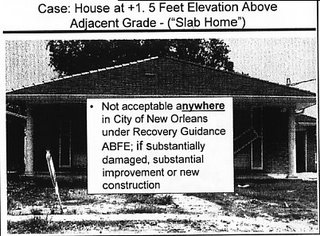
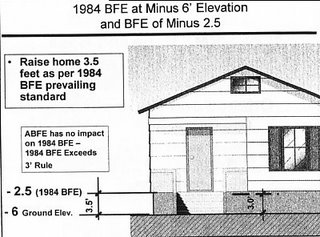
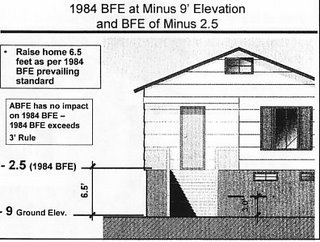

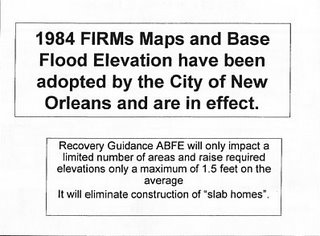


0 Comments:
Post a Comment
<< Home